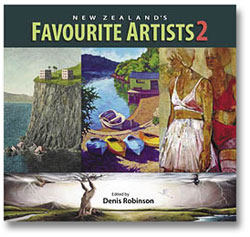News & Media
Showing now on Parliament TV (NZ) & YouTube: Liam Barr, Living the Art Life - Te Ora Toi.
May 2025
Late in 2023 I did an interview with Andrew Hagen of Urban Art NZ to capture some dialogue about my art practice. Over the following 18 months this evolved into number two in the arTVox series, looking closely at the works of accomplished New Zealand artists and is due to be shown on Parliament TV over 2025 and beyond. Most of the kid friendly images are here including a little commentary and a couple of my poems read by myself.
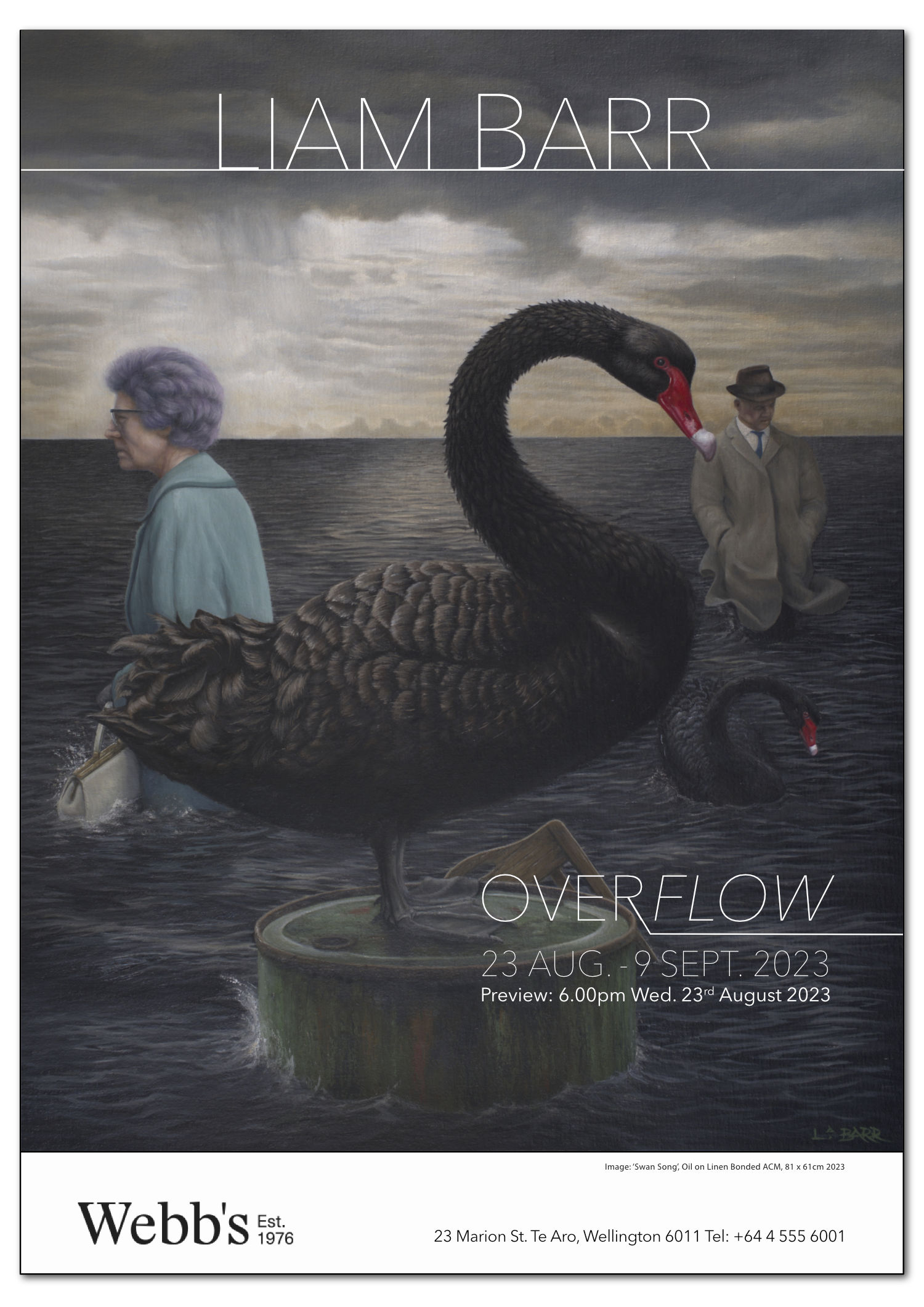
Overflow
August 2023
Overflow is a pressure release valve, a warning signal, an omen and an invitation. It emerges from years of observation, witnessing the destruction of flora and fauna through farming and forestry practices, genetic engineering and in more recent times the impact of excessive water on our environment, revealing the unmistakable, interconnectedness of it all.
Overflow is a series of personally charged, environment themed works with contemplative reflection at its heart. Solitary figures are locked in dialogue with the viewer in an intimate exchange, inviting us to meditate on the imbalances reflected in our climate-changed world. While this collection of work spans several years, a common thread unites them. These figures exist alone with their thoughts, grappling with the unfamiliarity of change, questioning and seeking connection and clarity.
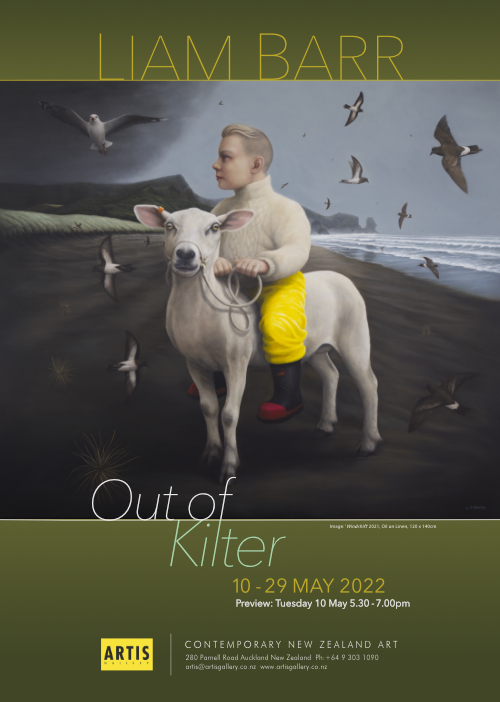
Out of Kilter
May 2022
Review by Michael Dunn.
Liam Barr’s paintings since 2018 continue to astonish. He surprises us by bringing together two or more realities like a young woman holding a grown horse in her arms as in the show Tethered (2018). We know it is impossible in the real world but by changing the rules of scale we are familiar with he makes it tangible in his painting with a highly detailed and finished technique of representation. Like dream imagery, like the world of Alice in Wonderland, Barr’s imagery is independent of the rational and the literal in its search for feelings and meanings beyond everyday experience. The innocence of a child’s view surfaces several times in his show Out of Kilter, 2022. For example, in Showdown a young boy dressed like a sheriff points a pistol at us, playing a role where violence is celebrated and unquestioned. In Praxis from the same show a disused playground recalls the toys of childhood where, by trial and error, we unknowingly prepare ourselves for the challenges of adulthood.
In their masterly display of the beauties of the natural world Liam Barr’s paintings strike a deeper more disturbing note as we contemplate them. For example, in An Ordinary Gesture a man stands knee deep in water signalling to us ambiguously, presenting a quandary; is he saying ‘hello’ or ‘goodbye’. Barr has considered the work carefully and it demands reflection not just a quick look. There is no clear narrative – no one meaning. He seems to capture some of the uncertainty of the post Covid world in which there is confusion and fear. In Windshift the boy seated on a sheep has a backdrop of the Te Henga shoreline and looks towards the approaching storm and weighs his options, as Barr writes in his notes. For both young and old these are parlous times and the new paintings shown in Out of Kilter capture the psychological stress of the situation.
Bringing together the unexpected was central to the Surrealist movement as was removing the subject matter from a normal context. The Surrealists worked during the uncertainties and political turmoil of the period between world wars. Liam Barr has always had affiliations with Surrealism and now works in a comparable time of political and social upheaval. His painting is a vehicle for reflecting upon the issues that now confront society world wide.
Michael Dunn

Submachine Magazine
December 2021
Article and image exposé by Al Best.
OPEN YOUR
EYES AND
DREAM - THE CALMING, CONTEMPLATIVE,
MAGNETIC AND EVER-SO-SLIGHTLY
HAUNTING PAINTINGS OF LIAM BARR
When we begin to emerge from a deep slumber there’s often a tantalising, desperate moment where it seems
possible to re-enter a dream. Liam Barr is here for you, holding the door ajar, calling out to guide you back
from the harsh reality of the waking world. Welcome to the simultaneously surreal and strangely familiar...
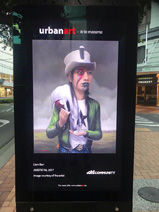
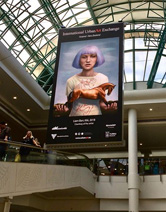
International Urban Art Exchange - Finland
January/February 2020
As an extension to the Urban Art solo exhibition (retrospect) in Wellington, the initiatve extends to the International Urban Art Exchange with Finland where my work will be exhibited among other notable NZ (Karl Maughan, Derek Cowie, Heather Straka, Elizabeth Thompson, Paul Martinson, John Walsh, Grant Sheehan, John Pule, Graham Fletcher, Sara Hughes and Dick Frizzell) alongside Finnish artists in large scale digital format both here through various hi profile street scapes, shopping complexes, air ports etc. In June 2020 this exhibition will then exhibit in Turku, Finland displayed on a 50sqm digital screen in downtown Turku.
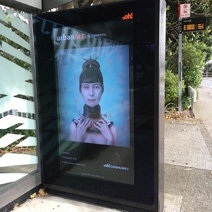


Retrospect - Hitting the streets of Wellington
January 2020
2020 has a retrospective of my work exhibited thoughout Wellington streets via Urban Art Foundations initiative to promote NZ art to a wider community. A dozen or so images rotate their way to through Ooh! Medias digital billboards.

Art New Zealand Magazine
Edition Autumn 2019
Article: Strange & Memorable by Michael Dunn
Liam Barr is a painter who has established a persona that does not fit easily into one category of contemporary painting. He merges a number of styles into his works but at all times remains figurative and realist in type. Born in Scotland, he came to New Zealand aged eight and seems to have been self-taught apart from some training in graphic art in Perth. He has been exhibiting for over ten years and is based in Wellington. His latest Auckland show at Artis Gallery in Parnell had the title Tethered and, as this implies, the works have references to the horse in their imagery.
In his catalogue notes for the show Barr writes:’ I have always been drawn to the horse, perhaps because I was born in the year of the horse or perhaps it is their sheer magnificence.’ All the paintings in the show have the horse as a component part of the subject matter. The horses are not generic but individualised and varied in type from one painting to the next. Barr introduces the horses into compositions that have half-length portraits set close up to the picture plane. He explains: ‘In this series of portraits I am exploring the idea of displacing these statuesque and by nature ‘free’ beasts from their natural environment and placing them within our domestic environment as things we own and indeed control.’
One could object that we no longer live in the age of the horse and that for most of us the horse is an unfamiliar part of our domestic environment. Furthermore the horses in these paintings are reduced in scale to the size of family pets, such as a cat or dog, which creates a strange and disturbing feeling in keeping with Barr’s penchant for the surreal. Such changes of scale are used quite a lot in his art to give effects of disjuncture and discontinuity of time and space. By scaling down the horses he can fit them into small spaces and, in some cases, have them held by the figures in their arms, or in Ponytail, have them attached to the face like appendages or growths.
The portraits, if they can be called that, for we do not know who the people are, seem to be detached form the horses rather than to own them, and not to belong to the horsey set. In most cases the portraits with titles like Aubrey, or Persephone, are of young women. Some are dressed in gowns and, in one case, with a necklace. The subjects deal as much with the beauty of the women, who possess the horses as accessories, as with the horses themselves. The realistic depiction of the horses, as in Genus, where the texture and sheen of the horse’s hide has an illusionistic quality, recalls the Renaissance painting by Leonardo, Woman with an Ermine, where the portrait of the Milanese duke’s mistress is enhanced by the feral creature she holds, as if captive to her charms. The palpability of the ermine, like Barr’s horses, gives a vivid sense of reality to the otherwise fanciful encounter between woman and beast. The appeal to the viewer in both Leonardo and Barr is an important component of the works. The youth of the women and their physical attractiveness, in conjuncture with the horses, are critical to the success of the series.
An oddball is Sweetie Pai, which shows a Maori girl with a moko and hat adorned by a huia feather. This is an edgier work with a more contemporary feel. Barr informs us in his notes that it is a tribute to David Bowie. ’The Maori girl presents her culture like a time traveller, informing the multi-layered influences of her experience. The horse acts as a symbol of freedom, instinct, intuition and status.’ However, this reading is far from clear in the image where the white horse, draped like a dead goose over her shoulder, timidly sucks some sugar cubes. This portrait has some grandeur against the backdrop of a threatening sky but seems to deny any exact exegesis. Strangely this ambiguity is part of the power of these portraits – they deny a clear narrative, such as we find in some earlier works by Liam Barr, like his Minnie Dean, 2012, where the story of the infamous baby killer is spelt out clearly by the railway station sign, the train, the hat box and bottle of laudanum.
The painting called Persephone is one of the most compelling of the portraits. It shows the head and shoulders of a young woman viewed close up holding on a platter, for our attention, a miniature landscape with a pasture, tree and horse all scaled down to toy size. The conception of this offering recalls those Baroque paintings where the decapitated head of John the Baptist is held out by Salome on a platter. In Persephone the dreamy, mournful expression of the sitter does evoke the story of the classical maiden seized by Pluto and taken to the underworld for the greater part of each year and only allowed to come to the surface in spring-time. This seasonal reference in the myth can be related here to the skeletal tree denuded of foliage, symbolic of winter when she must return to the underworld. Persephone, the horse by the tree and the landscape wait for rebirth and freedom, through the progression of the seasons.
The only specifically male portrait is called Whisper. It has gravitas because of the sitter’s maturity, his thoughtful expression and his face being shown full frontal close to the picture plane. In composition, it takes up an old image found in depictions of Christ as the good shepherd holding a lamb over his shoulders protecting it from harm. In Barr’s work the horse takes the place of the lamb, but has the same protective connotations. This is a new age man not a hunter with his dead prey. The cloudy sky behind the portrait gives drama to the work and supports its message of salvation from danger. Whisper has the attributes of an icon. It is a work to be meditated upon as well as looked at. The male sitter, a self-portrait, serves as a saviour of the horse which now depends on his assistance for survival in the modern hostile environment.
Throughout his career, Barr has followed an individual path feeling free to cross over between genres that appeal to him from surrealism to pop to photo-realism. Despite this eclecticism, looking back at his work, it is possible to find an identifiable style. He ranges across subject-matter drawn from history and mythology, from European to Maori. There are political and social concerns in some of his paintings. David, 2016, for example, is concerned with commercial gain at the expense of the environment, and targets greed, a vice he finds widespread in society. The Sheriff, 2011, portrays a feisty nude, whom he has called a no-nonsense woman, with her outstretched arm and hand serving as a gun with a realistic bullet fingernail. His women are not only strong characters but somewhat threatening. His Tiki paintings have some of the irreverence of Dick Frizzell in their cartoon-like imagery but show his attempt to embrace the forms of Maori art and to integrate them in his paintings.
In his art, Barr has consistently looked back to the past seeking the strange, the tragic and the memorable as subjects for his paintings. At times he has composed verses to accompany his imagery and to add information helpful to interpreting it. For his works are never strictly historical. There is usually a message to be found in them. For example, in Buller’s Birds ( Avaritia non habet Legem) 2009, he presents a seated figure of Buller holding a now extinct huia in one hand with other birds surrounding his person. His near maniacal intensity reveals Barr’s critical view of him, a view clarified further in his verses written to support the portrait. 'Buller ‘o Buller what corrupted you so/ you killed our poor birds for what I don’t know/ Was money the driver for the thousands you killed…’ The Latin phrase of the title translates ‘Avarice knows no laws’. He sees that having a scientific purpose, as Buller did to record the avian species, does not justify the wholesale slaughter and extermination required by his methodology. Barr comes across as a genuine conservationist with a real concern for New Zealand’s flora and fauna. But his manner of conveying his concerns is far from dry and proselytising. It is engaging and provocative and allows the viewer to get involved through his wit and striking juxtapositions of subject-matter.
Barr’s early series Hei-Tiki – Hi Mate - Pou of 2007-8 provides a useful comparison with Tethered in assessing his development as a painter. Both series are ambitious in their conception and execution but the earlier one seems more awkward and unresolved. In it he attempts a hybrid figurative style which integrates the tiki motif of Maori carving with European-type figures and landscape backgrounds. An example is Totara Graveyard, 2008 where a seated hybrid Tiki figure sits amidst a landscape of dead tree stumps and bare hills. In his notes the artist tells us that Tiki ‘laments over the twisted sculpture silver giants which once stood to provide a majestic skyline.’ His attempt to address bi-cultural issues and ecological concerns is commendable but somewhat unsuccessful. The wooden Tiki face is not a suitable vehicle for expressing the emotion required and the hybrid mixture of Maori and European conventions is uneasy rather than meaningful. Comparatively Tethered is more accomplished while still being provocative and thought provoking.
Liam Barr has experimented with a range of sources, styles and themes in his paintings over the past ten years or so becoming in the process more subtle and effective as an artist. As a show Tethered seems more mature than its predecessors, yet has clearly grown from them in many ways.
Michael Dunn
Wednesday, 26 September, 2018

Journal Magazine
Edition Spring 2018
Cover feature and image inclusion (Pony Tail 2017) in article 'Mind over Matter'
Journal - Edition 3 - Spring
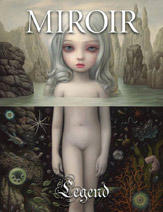
Miroir Magazine
Published 19 January 2017
Nice to have my paintings 'Salvation' and 'Postscript' featured in the latest edition of Miroir.
Featuring: Mark Ryden, Steven Kenny, Benjamin Vierling, Alex Gross, John Brophy, Caia Koopman, Casey Weldon, Tom Bagshaw, Christina Ridgeway, Kindra Nikole, Liam Barr, Bruno Wagner, Sonya Fu, Nina Pak, Jennybird Alcantara, Ryan Blomquist, Jared Joslin, Rachel Bess, Teiji Hayama, Troy Brooks, Ransom & Mitchell, Brad Kunkle, Duma, Elena Helfrecht, Sarah Joncas, Kristin Shiraef, Nicoletta Ceccoli, Katarzyna Matenska, Jo David, Stefania Airo / Riccardo Roberti, Dilka Bear, Nathalia Suellen, Karen Wight, MeduSirena Marina, Yuko Yabuki, Jasmine Worth


The magic realism of portraiture - Workshop
Workshop and Presentation 16 - 20 Jan, 2017 - Corban Estate Art Centre
5 days, 11 students and a great opportunity to share some knowledge and offer alternatives to how people approach their new painting project. The workshop was very successful and highly enjoyable, watch this space for more opportunities like this. Photo / CEAC.


Artis Gallery
Summer Selection 6 Dec 2016 - 28 Feb 2017
Currently showing in this fine group exhibition. Make sure you ask to view the stockroom downstairs where I have a number of other works.

BloPop Magazine Vol:2
Contemporary art for the ordinary Human. Launched May 2016
Proud to be a feature artist in this new magazine bringing you the best in the hippest pop culture art from around the globe.
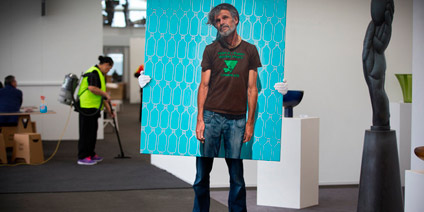
Auckland Art Fair back with a bang
Wednesday May 25, 2016
Jonathan Gooderham, managing director of Artis Gallery, holds Liam Barr's oil painting 'David' as gallerists set up for the art fair at The Cloud. Photo / Brett Phibbs
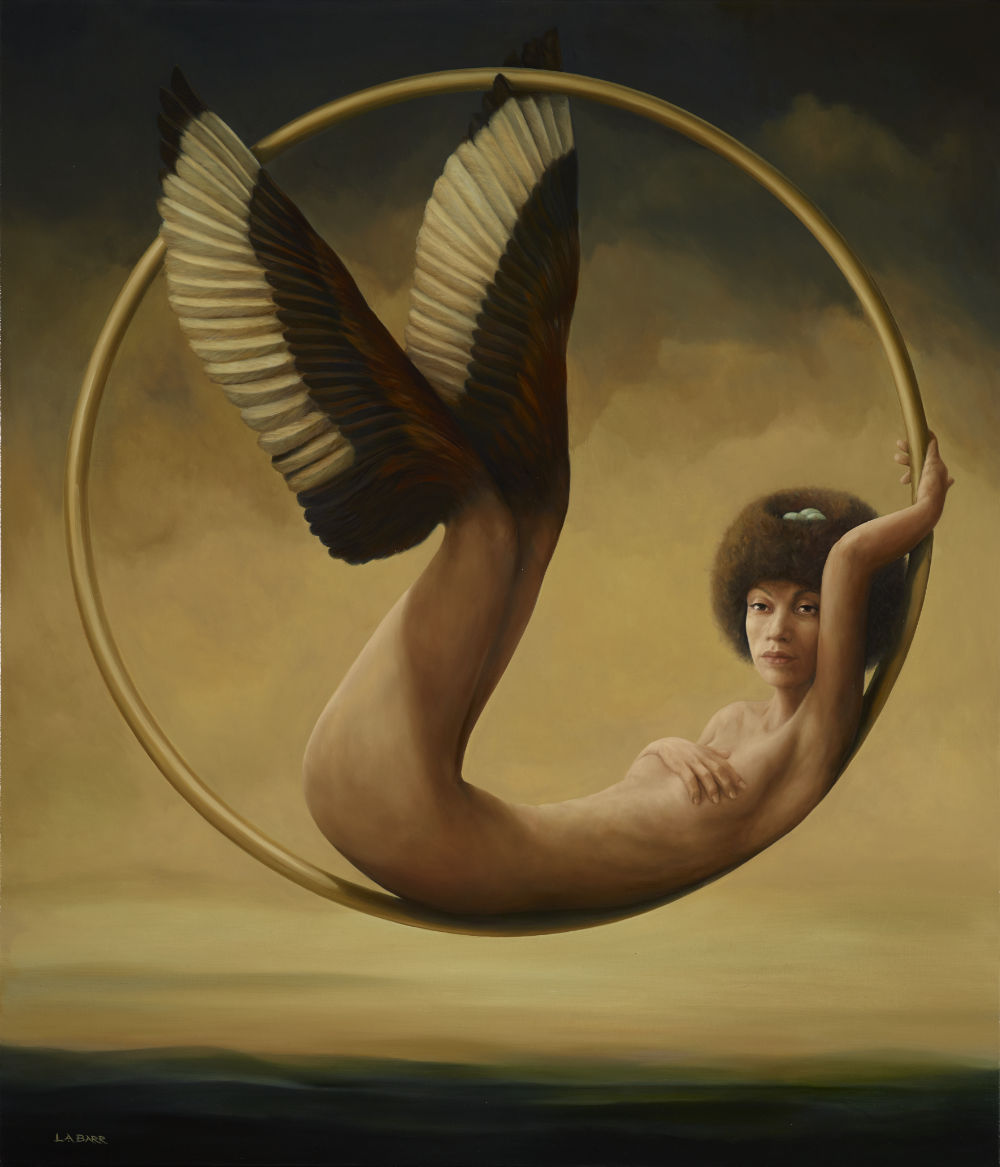
Review: AVIAN - T.J. McNamara: The wealth of human figuratives
Excerpt: NZ Herald, Saturday April 16, 2016 by T.J McNamara
Artists delve in to expression embracing their interpretation of mankind.
Amid the welter of styles used by artists nowadays, there still remain places for the human figure. The paintings in Avian by Liam Barr are also figurative, much more smooth, less hectic but equally odd. They are big works in oil on linen largely in shades of grey and generally depicting a humanoid creature with wings. The wings are not attached to the shoulders like an angel but rather to thighs, legs and fingers. They are all highly skilful feats of drawing giving the feeling not only of muscles, but also the bone beneath the skin. The skill extends to the dim landscapes or cloudy skies that are the setting for these creatures.
Most spectacular of all is a full-frontal nude woman with bobbed hair like a helmet and vast black wings sweeping from her hips to under her feet. She also sports a tuft of white at her neck in keeping with the title of the work, Tui. She supports herself in space by spreading her arms on an all-encompassing ring perch.
The rings occur elsewhere. They suggest the figures are captured, but not caged, like falcons. Several wear hoods that reinforce the same concept. Notably the ring supports a man grotesquely hooked under the protruding clavicles of his shoulders.
The figures have elements that have been part of Barr's earlier work, such as elaborate neck braces and strange decorations. One figure is completely naked; he is a timorous youth looking upward for help while crouching on a wide empty plain.
The prevailing shades of greyness confer the realism of photography. Only one work, Plume, is in gentle colour and it also introduces a note of humour with the bird theme supported by blue eggs nesting in a mop of hair as well as big wings on the figure's legs. These images are symbols of the human condition that aspires to heights but is handicapped by human limitations.
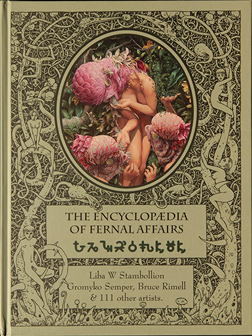
The Encyclopedia of Fernal Affairs
Launched, May 29, 2015
Proud to have my painting 'Spirit me gently to the sea' included in the plethora of amazingly creative outpouring of artist collaborations around a book theme and then exhibits a selection of the work.
From the fertile and Fernal imagination of artist Gromyko Semper, the Fernal universe was born.
The Garden
The Garden of Fernal Delights is a sublime and paradisiacal place where all the delights of the natural world from the sexual to the surreal, the visionary to the instinctive, are celebrated as fundamental joys of being alive. The Garden is a multi-dimensional place where all is conscious and divinely intelligent from the animal to mineral to vegetable to the etheric. All can communicate, co-create, cooperate. This Garden of Delights knows no violence, no notion of original sin, no hierarchy, no fixed temporal system. Rather it is a place of magic, of play and playfulness. It resides in the Garden of the heart and has no limit to its creativity.
Explore the book further,

Liam Barr, An Eclectix Artist Interview
April 21, 2015
New Zealand artist Liam Barr creates fantastical portrait narratives which spark questions and hook us with surreal, old world mystery. ( Witness the masterpiece above, his killer portrait of the writer Katherine Mansfield! ) Liam's finely honed skills communicate with delicacy, insight and compassion on the human condition. They can feel barren, desolate almost gothic - yet at the same time full of thoughtful humble soul. A breath of sarcasm and irony delve into his more serious concerns - of spirituality, mortality and one's role in life. We thought it best to let Liam do the rest of the talking here, as his articulate thought and honesty are their own rewards.
Liam Barr, Eclectix Interview 58,
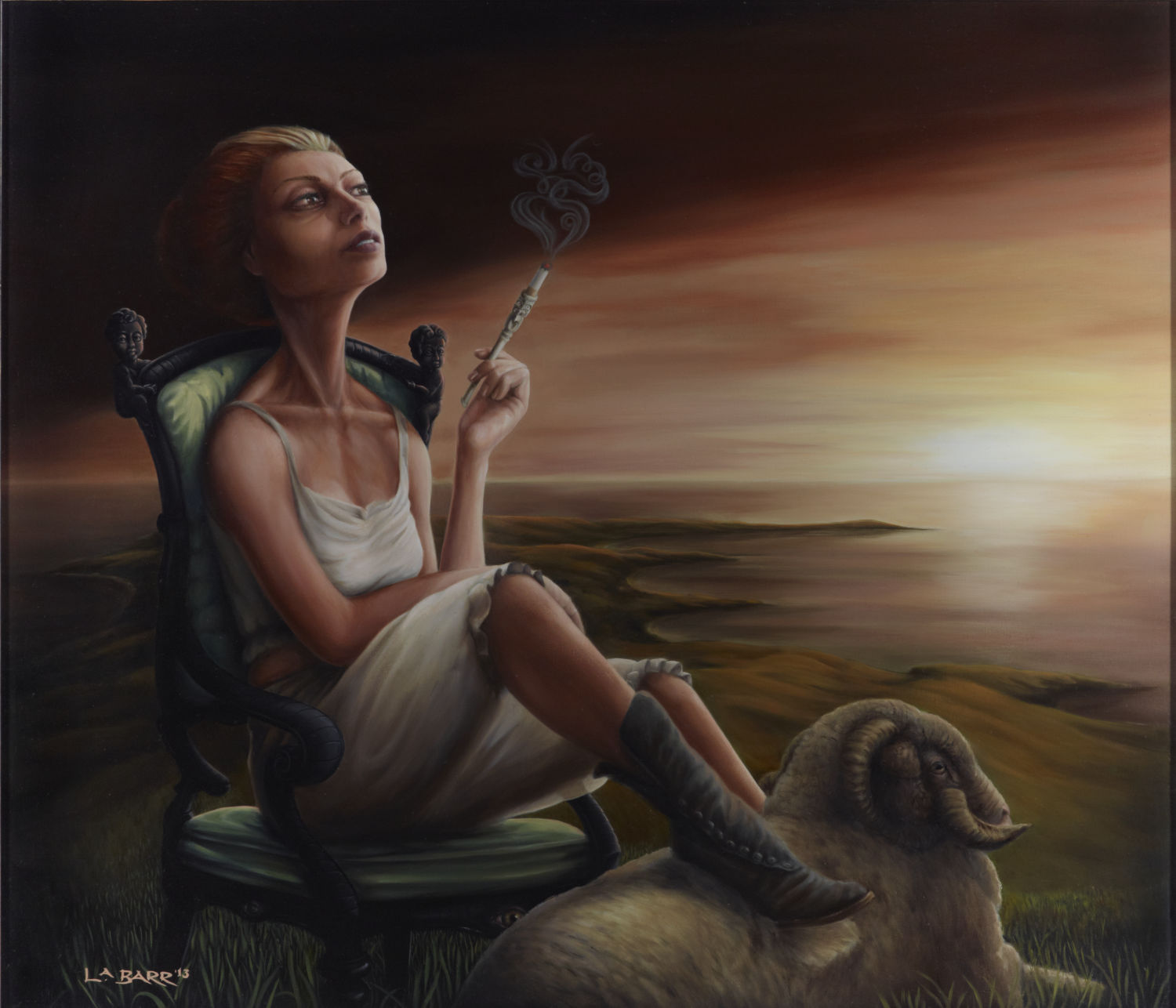
Within the 'Scape' you'll find a 'Contemplace'
This spring through summer, my painting 'Contemplace' is to be included in 'Scape' Whakatane Art Museum, Opus Gallery, Te Koputu a te whanga a Toi, 24 October 2014 to 18 January 2015. This exhibition features a selection of contemporary artworks exploring changes in the artistic representation of the New Zealand landscape - from a symbol of national identity to landscapes of myths, dreams and memories. Exhibiting work also by Andrea Gardiner, John Walsh, Andrea du Chatenier, Michael Hight, Matthew Couper, Julia Hooper and local artists Helen Lees and Lea Anne Sheather.

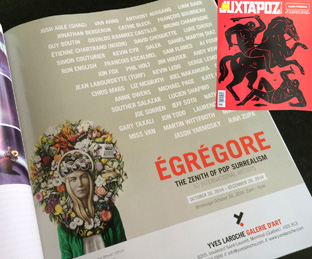
The Zenith of Pop Surrealism,
My latest painting 'Wed to the Wheel' features as part of Égrégore, The Zenith of Pop Surrealism, Yves Laroche Galerie D'art, Montréal, Canada. From the 31 Oct - 20 Dec 2014
ARTISTS: Josh Agle (Shag), Van Arno, Anthony Ausgang, Liam Barr, Jonathan Bergeron, Cathie Bleck, Francois Bourdeau, Guy Boutin, Osvaldo Ramirez Castillo, Bruno Champagne, Étienne Chartrand (Nixon), Romulo Cesar, David Choquette, Luke Chueh, Dave Cooper, Simon Couturier, Kevin Cyr, DALEK, Daniel Martin Diaz, Ron English, Daniel Erban, Francois Escalmel, Sam Flores, AJ Fosik, Jon Fox, Phil Holt, Jim Houser, Andy Kehoe, Jean Labourdette (Turf), Kevin Ledo, Serge Lemonde, Chris Mars, Liz McGrath, Joel Nakamura, Annie Owens, Michael Page, Kate Puxley, Souther Salazar, Lucien Shapiro, Amy Sol, Joe Sorren, Jeff Soto, Nathan Spoor, Gary Taxali, Jon Todd, Laurence Vallieres, Henriette Valium, Miss Van, Martin Wittfooth, Max Wyse, Jason Yarmosky, Ravi Zupa

New Commemorative Artwork for New Zealand Defence Force
Media Relaease NZDF June 27, 2014. Photo: Corporal Sam Shepherd
Hon Michael Woodhouse, Minister of Veterans' Affairs, has been presented with an oil painting by Wellington-based artist, Liam Barr, on behalf of the New Zealand Defence Force (NZDF).
Both Mr Woodhouse and Mr Barr travelled to Korea in July last year with a NZDF contingent and New Zealand veterans of the Korean War last July to attend the 60th anniversary of the Korean War Armistice.
"This painting will stand as a lasting testament to the New Zealand contribution to the Korean War, and recognise those who fought and died there in service to their country," says Mr Woodhouse.
Mr Barr says the painting, titled The Weight of Silence, reflects his experience of the commemorations and the conversations he had with the veterans. "Initially, I thought the painting would be more historical in tone - images of uniforms, good keen blokes, the battle-weary," said Mr Barr. "But as I listened to the veterans' stories and observed their reactions to the commemorations, I felt the painting needed to reflect the emotion on returning to Korea sixty years after they had fought there."
The oil on linen painting is based on a photo Mr Barr took of veteran Mr George (Tim) Flintoft who happened to be the first veteran Mr Barr met before the contingent departed for Korea. Mr Flintoft stands in formal attire, cane in hand, wearing his military medals and South Korea's national flower 'The Rose of Sharon' (Hibiscus Syriacus) pinned to his right lapel. He stands before a koru-engraved portion of the New Zealand Memorial at the United Nations Memorial Cemetery in Busan.
Poppies float around Mr Flintoft as a symbol of the fallen. Mr Barr's commission follows in the tradition of New Zealand war artists. The system of appointing official war artists by the Government of New Zealand dates to the latter stages of the First World War. The success of that experiment led to a similar programme of appointing official war artists during the Second World War.
In the post-war era official artists have been engaged from time to time to record overseas deployments, ceremonial occasions or other events deemed to be of particular contemporary importance. Since 2012 there have also been a series of official NZDF artists engaged to record events and personalities of significance to all three of the Services: Navy, Army and Air Force.
Supplementing these officially commissioned artworks have been artworks produced by Service personnel themselves. Held in museums and galleries throughout New Zealand, but also forming a major part of the National War Art Collection held by Archives New Zealand, these unofficial works greatly enrich our cultural understanding of conflict and military service.
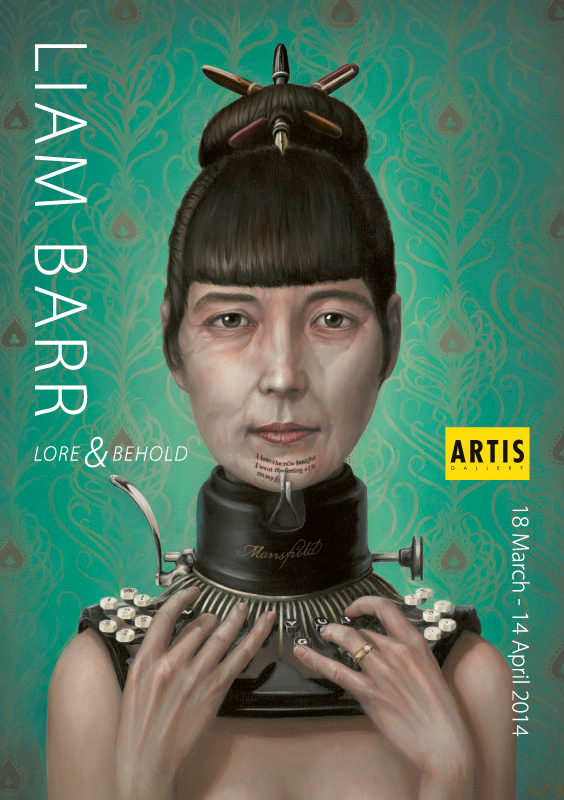
Review: Lore & Behold - titled: I love the rain tonight
Excerpt: Auckland Weekend Herald, Saturday April 5, 2014 by T.J McNamara
'The exhibition by Liam Barr at Artis Gallery is called Lore and Behold. In his highly polished paintings we behold the lineaments of a person and equally realistic accompaniments that convey stories, real or imagined, about their past.
A typical example is Postscript where we encounter the direct gaze and pale face of Katherine Mansfield. Her familiar bobbed hair is crowned by old-fashioned fountain pens and her profession as a writer is emphasised by the keyboard and typewriter carriage bent as a tight collar around her neck.
As an adolescent she learned to type because she knew she would become a writer. Her long fingers tap out her last words, "I love the rain tonight", as a tattoo on her chin. The whole shape resembles a lamp and recalls the importance of a lamp in her most famous story, The Doll's House.
Whether one is acquainted with the writer and the lore about her or not, it is an intriguing and skilled image.
Other works are not so explicit in reference. Requiem for the Feathered has an arched window showing a landscape with a naked woman leaning in with candles in both hands. She is assailed by a group of birds that have pecked elaborate tattoos on her shoulders and breasts. This work has the surreal quality of a dream but it is the dream of the woman herself. We can admire it but do not share in it.
A simpler image with the same dream quality is Spirit Me Gently to the Sea showing a pale woman waist-deep in a great river. The reference is to legend or lore. She embraces a large eel made special by a ring in its nose. The woman's long black hair is an effective part of the design.
These paintings carry a sense of mystery. Others are more obvious. The four grim Brides of None are fierce and armed while Contemplace, elaborate though it is, has none of the scope for imagination that gives an extra frisson to the rest of the show'.

HEY! MODERN ART & POP CULTURE #13
Interview Plus 8 Full Page Images
Release Date, Mar. 14, 2013. Ankama Editions. Paris, France.
HeyHeyHey.fr

Images & Poems: DEVINING THE DREAM by LIBA W. STAMBOLLION
61 international artists and 26 poets take a turn around the Wheel of the Year.
Release Date, Oct. 2012. Dreams & Divinites. Paris, France.
For book purchases contact Dreams & Divinities
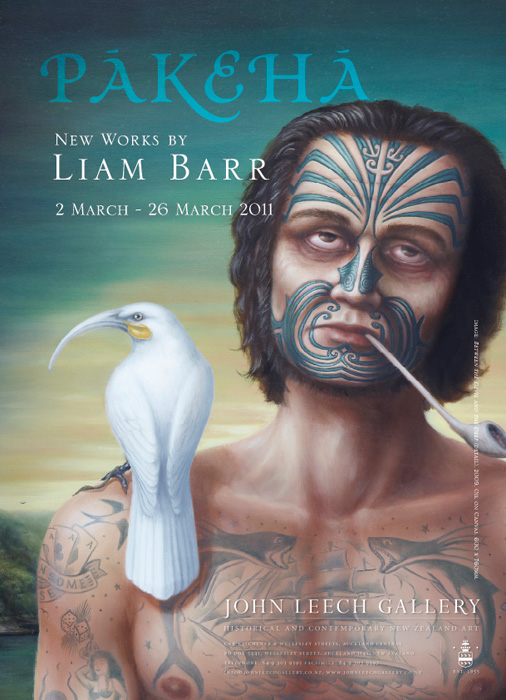
Review: Vein of grotesque runs in festival offerings
Excerpt: Auckland Herald, Saturday Mar 12, 2011 by T.J McNamara
The vein of grotesquery continues in the work of New Zealand resident artist Liam Barr, whose work at the John Leech Gallery represents a huge advance on his previous exhibitions. His painting has become more subtle, more delicate and his vision sharper. This show, called Pakeha, is devoted to images of 19th century English immigrants looking uncertain in their new country on the other side of the world.
A typically potent image is Mistress Molly. A tightly corseted lady, her head held rigid by a boned collar, delicately fans herself in front of a bed, under a wall of muskets. Her chest is tattooed with the heads of her conquests. She is a strange creature in an alien land and the image is skilfully and thoughtfully realised. Tattoos play a part in other paintings of men who lived with the Maori and adopted the moko.
The most telling portraits are the ones with unexpected detail that reinforces the sense of well-intentioned intruders. A notable example is Promise and Prayer, with child-like figures having a simple picnic with teapot and cups under the head of deer they have introduced and a dead tree with a lake and empty land in the background. Carved on the tree is the hopeful rubric "Home Sweet Home" which it demonstrably is not.
The tension in these paintings of symbolic figures of 19th century pakeha is on several levels. There is a tension between colonials and the landscape as well as a strong sexual tension, notably in Aurora's Figaro. The image is quite complex. A girl with a whip stands on a tin drum while a boy with a horse's head cavorts before her. In his hands are the coconut shells that were used to make clip-clop sound effects in the theatre of the time. They are in a tidy garden but beyond the gate is again a wide trackless landscape. The woman in the centre of Amberley, with her fox fur draped around her shoulders, is a powerful image of lonely repressed desire for many things as she clutches a musket for protection. All of these images go much further into human realities than the stylised figures that dominated the artist's previous work.
These three exhibitions grace the festival but show that contemporary artists do not seek beauty for itself. They are looking for previously unexplored feelings and means of expression.
Press Release: Pakeha - Text by Kelly Ana Moray
Fiction and history collide in Pakeha, Liam Barr's latest suite of narrative paintings which depict those first tentative steps, environmentally, socially and physically, of the Pakeha on the Empire's youngest country.
These paintings, these intriguing characters, are incredibly rich in story as Barr meticulously, and very beautifully visually references New Zealand art/history; the colonisation process; the land; cartography; and the psychological, sociological and domestic impact of these things on the individual.
The main body of work comprises of fictional characters: the likes of Mistress Molly and Faethm are vessels for narratives regarding Pakeha New Zealand's cultural mythology with its themes of displacement, determination and toil and the human and environmental cost of those things. And this is no triumphant colonial history, beneath the veneer of Victorian finery and palatial abodes, the damage can be clearly seen. These are indeed turbulent times. And like any good history story, Pakeha is underpinned by real life personalities, in themselves a part of New Zealand's mythological and cultural fabric. There's Kimble Bent, the Pakeha Hauhau, John Rutherford and Walter Lawry Buller, with his beard full of birds.
Pakeha offers a wealth of fascinating, if not always admirable stories, which lie at the heart of Pakeha New Zealand's young, and at times violent, history and the impact of that on not only the people but the land itself.
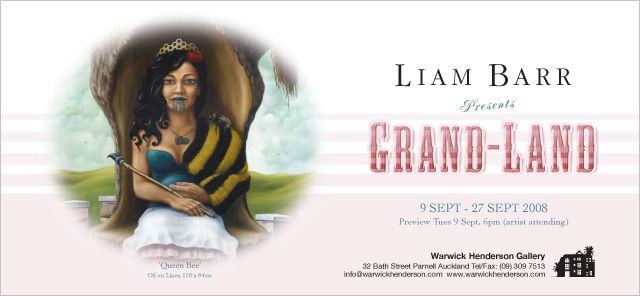
Review: Raise a glass to the small things
Excerpt: Auckland Herald, Saturday Sept 20, 2008 by T.J McNamara
At the Warwick Henderson Gallery, Liam Barr is thinking grand in a show, Grand Land, in which he seeks to combine reality and myth, history and the present. He has evolved a stylised Cubist Maori figure to represent Tane and taniwha. His style works splendidly in the painting, Tane, where the great god figure grows from the land toward the sky with the bush-covered hills becoming his cloak and feathers the snow on the mountain. He is the source of the water of life. The stylised face works very well as a mythological figure.
This is also true in Taku Turangawaewae where a monster born from the imaginings of the people confronts a kiwi, a much older inhabitant of the land. A newer arrival is signalled by a little church. The confrontation is awkward but the landscape is impressive.
In several paintings there is some fine work portraying lake, hill and sky. The quality of this landscape painting gives support to the awkward figures. Yet the awkwardness prevails altogether in works that refer to recent memory, such as the one that shows figures crammed in a pedal car on the footpath in front of a diary.
The real inspiration lies in the landscape and the myth, not in memories of icecream in summer...
Press Release: Artnews, Spring 2008
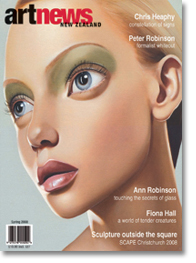
Excursions into Grand-Land
Wellington based artist Liam Barr surrenders 6 of his best in his upcoming show Grand-Land to be held at the Warwick Henderson Gallery. With the success of Hei Tiki - Hi Mate, his first solo-show with WHG, Barr pushes the theme of his tiki styled works to new depths and beyond. By combining the tiki figures with representational yet stylised figures, he opens up a dialogue for new avenues of exploration.
The overall theme of the show revolves around loose interpretations of a monarchical system, where quirky and often humourous perversions of kiwiana, Maori mythological figures, even kids in a pedal car act as permutations of kings and queens reigning over their moody and distinctly New Zealand domain. Throughout the works with their embodiments of power, there are woven softer narratives, where relationship, personal journey, cultural identity and mythology beg us to look into the well in search of deeper meaning.
‘Tane’, reigning omnipresent over his rich, abundant land, is a celebration of the New Zealand landscape but also perhaps a reminder of how much we have to lose. In stark contrast ’Mixed Bag’ bombards the viewer with iconography of a by-gone era, when everything could be bought for a dollar and a trip to the dairy marked the high point of a day.
There is no doubt there are subtle nods toward the pop surrealist & lowbrow art movement currently making huge impact in Britain and the US and offers a glimpse of things to come.
Little slips past Barr’s gaze as he weaves into his works precious New Zealand imagery and simply invites the viewer to engage with these narrative works, to draw out emotion and memory sparked by the New Zealand experience.
‘Grand-Land’ opens at the Warwick Henderson Gallery, Sept 9 - 27, 2008
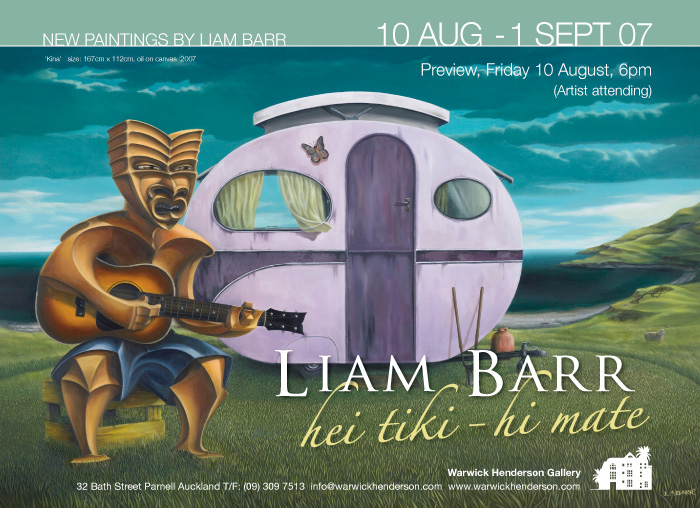
Press Release: Arts Editors Pick of the week
The NewZealand Herald: Time Out Magazine - Aug 9, 2007 by T.J McNamara
Warwick Henderson Gallery announces the first Auckland solo exhibition of emerging artist Liam Barr, "Hei Tiki - Hi Mate".
Barr's new exhibition references the tiki as an icon of New Zealand, drawing from the traditional imagery of the 'carved' tiki, from a rich and loaded history. These paintings reveal a contemporisation of the tiki where it appears as an exaggerated sculptural figure, anachronistically placed in both poignant and revealing situations.
There is a strong sense of narrative within this series. Although the 'tiki' carries common elements within all the paintings, each tiki appears to bear a new character. This central theme is symbolic of the larger picture which reflects an aura of pathos, displacement and insight into contemporary New Zealand with all its paradoxes.
Embedded within this narrative is a light and humorous perversion of kiwiana, where European icons have merged congruously with a traditional culture. In a satirical yet poignant way Liam Barr has bridged and depicted the effects of Biculturalism since European contact. Throughout this new body of work the tiki appears as the common denominator, riding a bucking moa amusement ride in "The Mighty Moa", carving in "Haere mai he tete kura - The arrival of a new frond" and almost dancing in front of a graffiti throw-up in "Che".Bent in mourning "Gods Own" the tiki provokes thought on the issue of Maori spiritualism and colonial religions. In "Kina" many of New Zealand's well known icons are played out where an empty "swappa" crate becomes a seat. There is a distinct playfulness within this image which portrays the cliche of a 'kiwi summer holiday' - a pale pink and purple caravan complete with kiwiana butterfly, and the tiki figure in full strum singing to his guitar. Here Barr's humour is backdropped with the vastness of a typical (beautiful) New Zealand coastal landscape.In "Te Onepu Pakaha - The Sand Castle", Barr states 'Koro (respected elder) rests easy at his whare, his home, his castle. He is comforted by the natural state of his environment where nostalgia blows from the north of a life so long ago, it could have been someone elses.'
With a long history of storytelling Barr chooses his cues - irony, satire and playfulness to magnify and perhaps draw a long bow to the duality of cultures. These paintings however are rich in warmth and light humour with more than a nod to the reality of Biculturalism. The brushwork, detail and compositional qualities of these exemplify the three dimensional quality of the subject matter. Painting of this standard and originality is well worth viewing.

Journeys to the other me
Press Release: Fremantle Herald - Dec 2003,
This exhibition explores journey, and the multiple manifestations of what it is to journey, Mankind's personal evolvement and of what it is to belong to the ever evolving throng of movement and the passing of mass, the passing of time & space, the passing of knowledge.
No man woman or child on their journey is complete without recognising their relationship
to the earth and the earths beasts. They represent a connection to our psyches. Just as we
make intellectual and emotional meaning from bright colours to dull colours so do we in
regards to the animal that walk, fly and swim the earth.
The environment holds a strong connection to where and who we are at any one time.
It not only places us in the picture geographically, but culturally as well.
